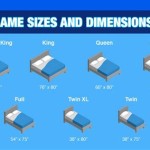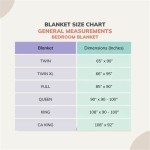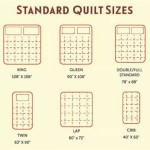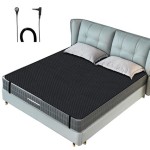Queen Size Vs. King Size Bed Dimensions In Feet
Choosing the right bed size is a crucial decision when furnishing a bedroom. The selection significantly impacts sleep quality, room aesthetics, and overall comfort. Two of the most popular choices are queen and king-size beds. Understanding the dimensions and suitability of each option is essential to make an informed decision that complements individual needs and spatial constraints.
This article provides a comprehensive comparison of queen and king-size beds, focusing on their dimensions in feet, advantages, disadvantages, and key considerations to aid in the bed-buying process. The aim is to equip readers with the necessary knowledge to determine which bed size best fits their lifestyle and bedroom layout.
The terms 'queen' and 'king' are established industry standards for bed sizes. While specific manufacturers may offer slight variations, the following dimensions represent the generally accepted measurements for these bed types.
Queen Size Bed Dimensions
A queen-size bed is a popular choice for individuals and couples seeking a balance between space and comfort. Its dimensions provide ample room for sleeping without occupying excessive floor space.
The standard dimensions of a queen-size bed are approximately 5 feet wide by 6.67 feet long (60 inches wide by 80 inches long). This equates to 152.4 centimeters wide by 203.2 centimeters long. These dimensions offer a substantial sleeping surface for one person, allowing for comfortable movement and preventing feelings of confinement. For couples, a queen-size bed provides reasonable personal space, although some individuals may prefer a larger surface.
Queen beds are well-suited for master bedrooms, guest rooms, and smaller apartments where maximizing space is a priority. Their versatility makes them a practical choice for a wide range of living situations. The relatively compact size simplifies maneuvering the bed during relocation, and offers greater flexibility when arranging furniture in a room.
Advantages of a Queen-Size Bed:
- Space Efficiency: Queen beds occupy less floor space compared to king beds, making them suitable for smaller rooms.
- Cost-Effectiveness: Typically, queen beds, mattresses, and bedding are less expensive than their king-size counterparts.
- Versatility: Queen beds work well in a variety of room sizes and configurations.
- Easy Maneuverability: Their smaller size simplifies moving and rearranging furniture.
Disadvantages of a Queen-Size Bed:
- Limited Personal Space for Couples: Some couples may find the sleeping surface too small, leading to discomfort and disrupted sleep.
- Potential for Motion Transfer: Depending on the mattress type, movement from one person may be felt by the other.
King Size Bed Dimensions
A king-size bed offers the largest standard sleeping surface available, providing ample space for individuals or couples who prioritize spaciousness and comfort. The generous dimensions cater to those who prefer to stretch out, co-sleep with children or pets, or simply desire the feeling of unrestricted movement during sleep.
The standard dimensions of a king-size bed are approximately 6.33 feet wide by 6.67 feet long (76 inches wide by 80 inches long). This translates to 193.04 centimeters wide by 203.2 centimeters long. The significant width difference compared to a queen-size bed provides a noticeable increase in personal space. Many couples find the king size provides ample room for comfortable and undisturbed sleep.
King beds are best suited for larger master bedrooms where the room dimensions can accommodate the bed's footprint without overwhelming the space. A small bedroom with a king bed may feel cramped, restricting movement and hindering the overall aesthetic appeal.
Advantages of a King-Size Bed:
- Maximum Personal Space: King beds offer the most personal space for couples, minimizing sleep disturbances caused by movement.
- Comfort for Co-Sleeping: The ample width comfortably accommodates children or pets who may share the bed.
- Luxurious Feel: The large sleeping surface provides a feeling of spaciousness and comfort.
Disadvantages of a King-Size Bed:
- Space Requirements: King beds require a large bedroom to avoid feeling cramped.
- Higher Cost: King beds, mattresses, and bedding are typically more expensive than queen-size options.
- Difficult Maneuverability: The large size makes moving and rearranging furniture more challenging.
Key Considerations When Choosing Between Queen and King Size Beds
Selecting the right bed size is a multifaceted decision that requires careful consideration of several factors. Beyond simply considering the dimensions in feet, individuals need to evaluate their personal needs, lifestyle, and the overall characteristics of their bedroom.
1. Room Size and Layout: The dimensions of the bedroom are paramount. Before making a decision, accurately measure the room's length and width. Ensure that the chosen bed size allows for adequate walking space around the bed and comfortable access to other furniture, such as dressers and nightstands. A general rule of thumb is to leave at least two feet of space on all sides of the bed. In smaller rooms, a queen-size bed will be a more practical choice, while larger rooms can comfortably accommodate a king-size bed.
Furthermore, consider the placement of doors, windows, and closets. Ensure that the bed's location does not obstruct access to these features or impede the natural flow of movement within the room. It is also worth considering the ceiling height, especially if you are planning on using a high-profile bed frame or headboard.
2. Sleeping Habits and Preferences: Individual sleeping habits play a significant role in determining the ideal bed size. If you or your partner tend to toss and turn during sleep, a king-size bed may be more suitable, as it provides ample space to move without disturbing the other person. Couples who prefer close proximity while sleeping may find a queen-size bed sufficient. Consider also whether you prefer to sleep with pets or children. If so, a king size may be a more comfortable option.
The type of mattress chosen is another important factor. Certain mattress types, such as memory foam, excel at minimizing motion transfer, which can be beneficial for couples sharing a bed. Before committing to a bed size, research different mattress options and determine which one best meets your needs and preferences.
3. Budget and Long-Term Investment: The cost of a bed extends beyond the price of the frame and mattress. Bedding, such as sheets, comforters, and pillowcases, will also need to be purchased, and these items are typically more expensive for king-size beds. Furthermore, consider the long-term investment. A higher-quality bed and mattress will last longer and provide better support and comfort, potentially saving money in the long run.
Factor in the cost of delivery and installation, as well as any potential disposal fees for your old mattress. While a king-size bed may seem appealing, ensure that it aligns with your budget limitations and that you are prepared for the ongoing expenses associated with owning a larger bed.
4. Aesthetics and Personal Style: The bed serves as a focal point in the bedroom. The dimensions of the bed should complement your personal style and the overall aesthetic of the room. A large, ornate king-size bed may be visually overwhelming in a small, minimalist bedroom, while a small queen-size bed could appear insignificant in a large, opulent space. Consider the proportions of the bed relative to the room's dimensions and other furniture pieces.
The choice of bed frame and headboard can also impact the overall aesthetic. Select a frame that complements the bed size and enhances the room's décor. A headboard can add visual height and interest to the bed, but ensure that it does not overwhelm the space or obstruct access to outlets or light switches.
5. Future Needs and Lifestyle Changes: Consider potential future needs and lifestyle changes when selecting a bed size. If you are planning to start a family or anticipate a significant increase in living space, a larger king-size bed may be a more practical investment. Similarly, if you foresee downsizing or relocating to a smaller home, a more compact queen-size bed may be a more suitable choice.
Evaluate your current and anticipated needs to ensure that the chosen bed size provides adequate comfort and functionality for the foreseeable future. This proactive approach will help prevent buyer's remorse and ensure that your bed remains a valuable asset for years to come.
By carefully evaluating these key considerations, individuals can make an informed decision that aligns with their personal needs, lifestyle, and spatial constraints. Selecting the right bed size is an investment in sleep quality, comfort, and overall well-being, making it a decision that should be approached with diligence and foresight.

King Vs Queen Bed What S The Difference Amerisleep
Mattress Size Chart And Bed Dimensions Guide 2024

Mattress Size Guide Secrets For Every Room Eachnight

Tapi Carpets

King Vs Queen Bed Measurements Layla

Queen Size Bed In Feet

King Size Vs Queen Bed Difference Comparison Guide

Which Mattress Size Should I Get Texas Makers

Uk Bed Sizes The And Mattress Size Guide

Mattress Sizes Chart Bed Dimensions Guide Purple








